How to cultivate the Scilla siberica
How to cultivate the Scilla siberica
To the genus Scilla (L., 1753) belong some bulbous plants of the Liliaceae family originating from Asia, Europe and Africa.
From their bulbs, similar to tulips, plants with long lanceolate and leathery leaves originate, with deep green colors, arranged in a central rosette crowning an erect peduncle that ends with a cluster inflorescence.
Within this genus we recall the Scilla siberica that begins to bloom, in mild climate conditions, already from the end of February.
and ideal for growing in pots or in the open ground where they can be flower beds of pleasant chromatic effect.
The Scilla siberica has numerous bell-shaped flowers, with a corolla composed of 5 petals, carried by hollow cylindrical stems of dark green color. Depending on the variety, there may be flowers in white, pink, deep blue, purple, etc. From fertilization, berries are obtained which have seeds with good germination capacity.
In this card we will see how to cultivate the Scilla siberica following the agronomic tricks and the most appropriate techniques.
The Scilla siberica is a plant that must be placed in sunny places or, at the extreme, semi-shadowed, to obtain abundant and colorful blooms. Moreover, even if it tolerates the cold it does not tolerate night frosts.
The soils where to cultivate it must be possibly loose (alluvial type) very endowed with organic substance and perfectly draining. If you grow in pots you can create a soil with equal parts of coarse silica sand and soil for very organic flowering plants.
As far as fertilization is concerned, it should be remembered that the Scilla siberica is a somewhat rustic plant which, if cultivated above all in soils or substrates rich in organic substance, does not need further nutritional supplies. However, for plants grown in pots it is advisable to give specific fertilizer for flowering plants diluted in water. The most suitable fertilizer to obtain abundant and colorful blooms must have a low nitrogen content and rich in phosphorus and must be administered every 30 days during the plant’s vegetative cycle, in spring-summer.
Furthermore, to help drain water from watering and to prevent the roots from rotting, it is advisable to place draining material on the bottom of the pot.
For Scilla plants grown directly in the ground these should be watered only in the case of a prolonged spring drought while for those grown in pots you will have to intervene when the soil is completely dry.
For the selection of the pots we recommend containers at least 20 cm tall and twice as wide for the installation of at least 10-15 bulbs, in order to obtain impressive blooms.
To carry out the multiplication of the Scilla siberica, as of other species of the same genus, one must intervene by division of the bulbs in autumn or by sowing in spring.
In the case of propagation by bulbs they are obtained, obviously plants identical to the mother, in the multiplication by seed, instead, we encounter the creation of different plants according to the genetic heritage of the parents.
The technique of implanting the bulbs takes place starting from the autumn period when the cloves detached from the mother must be planted in a soft and fertile soil with the apex turned upwards, at a depth equal to twice their height and at a distance of about 2-3 cm from each other.
At the end of the vegetative cycle, when the leaves are dried, it is advisable to unearth these bulbs by keeping them in the dark in places without moisture and stored immersed in containers or pouches with dry chips. Otherwise they can be left to dwell but they must be protected from the cold of winter with a light mulch of straw or dry leaves. In the same way the bulbs of the plants grown in pots can be left in the same container but placed in places sheltered from the summer sun and winter frost.
Repotting the Scilla siberica should be done when you realize that the roots come out of the water drainage holes or when the bulbs have grown occupying the entire space available. As a rule, the new vase must be a few centimeters larger than the previous one, providing for the replacement of the soil with the characteristics described above.
Finally, a hint about the diseases that this plant can encounter. let’s immediately say that the Scilla are all very resistant plants; the only drawbacks can be had with aphids and cochineals in spring, especially if it is exceeded with nitrate nitrogen, and with root rot in the case of an excess of irrigation or poor drainage of the substrate.

